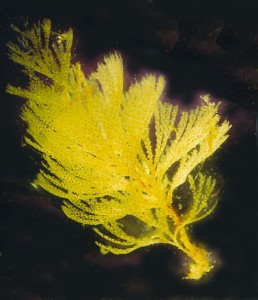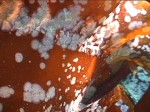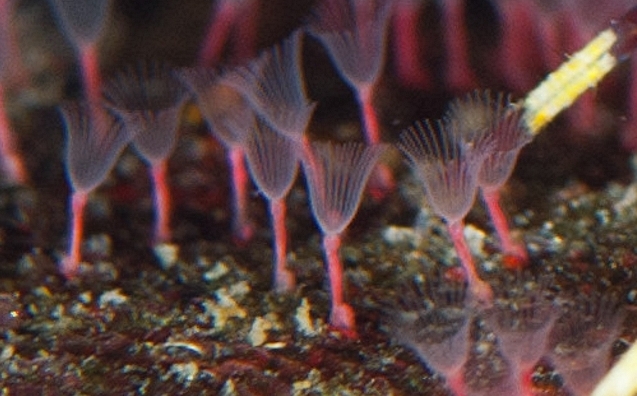 On October 24, 2011, Ryan Murphy took a picture of a coonstripe shrimp (you can see part of its yellow leg showing in this blow-up). In his photo background, he also captured by chance the first record of this species for the Race Rocks Taxonomy files. See this file explaining the significance of this find.
On October 24, 2011, Ryan Murphy took a picture of a coonstripe shrimp (you can see part of its yellow leg showing in this blow-up). In his photo background, he also captured by chance the first record of this species for the Race Rocks Taxonomy files. See this file explaining the significance of this find.
Tag Archives: Bryozoa
Bugula californica: Spiral Bryozoan- Race Rocks Taxonomy
This species is classified in The Lophophorate Phyla of British Columbia: Entoprocts,Bryozoans,Phoronids and Brachiopods by Aaron Baldwin School of Fisheries, U. of Alaska.
We see this bryozoan frequently in the lower intertidal while diving at Race Rocks in 8-12 metres of water.
“Each colony is hte result of budding or cloning from the original individual itself having developed from a planktonic larvae that settled … In the case of this species, the process is programmed as a spiral growth pattern. From ” Marine Life of the Pacific Northwest, Andy Lamb and Bernard P. Hanby ,2005,
| Domain | Eukarya |
| Kingdom | Animalia |
| Phylum | Bryozoa |
| Class | Gymnolaemata |
| Order | Cheilostomata |
| Suborder | Anasca |
| Family | Bugulidae |
| Genus | Bulgula |
| Species | californica Robertson,1905 |
| Common Name: | Spiral bryozoan |
|
|
and Image File |
 The Race Rocks taxonomy is a collaborative venture originally started with the Biology and Environmental Systems students of Lester Pearson College UWC. It now also has contributions added by Faculty, Staff, Volunteers and Observers on the remote control webcams. The Race Rocks taxonomy is a collaborative venture originally started with the Biology and Environmental Systems students of Lester Pearson College UWC. It now also has contributions added by Faculty, Staff, Volunteers and Observers on the remote control webcams. |
Disporella separata: bryozoa–The Race Rocks Taxonomy
This brightly coloured bryozoan, Disporella separata, can grow in patches 30- 40 cm in diameter. It may initially be mistaken for the purple variety of the Pink hydrocoral Allopora sp. It is found on the rocks right off the docks at Race Rocks in 8-12 metres of water.
This species is classified in The Lophophorate Phyla of British Columbia: Entoprocts,Bryozoans,Phoronids and Brachiopods by Aaron Baldwin School of Fisheries, U. of Alaska.
This brightly colored bryozoa can have patches 30- 40 cm in diametre. It may initially be mistaken for the purple variety of the Pink hydrocoral Allopora sp. It is found on the rocks right off the docks at Race Rocks in 8-12 metres of water
Rich : Animalia
Tribe : Bryozoa ( Moss animals)
Class : Stenolaemata
Order : Cyclostomatida
Family : Lichenoporidae
Gender : Disporella
Disporella separata
and Image File
 The Race Rocks taxonomy is a collaborative venture originally started with the Biology and Environmental Systems students of Lester Pearson College UWC. It now also has contributions added by Faculty, Staff, Volunteers and Observers on the remote control webcams.
The Race Rocks taxonomy is a collaborative venture originally started with the Biology and Environmental Systems students of Lester Pearson College UWC. It now also has contributions added by Faculty, Staff, Volunteers and Observers on the remote control webcams.
name –year (PC)
Heteropora pacifica: Staghorn Bryozoan–The Race Rocks Taxonomy
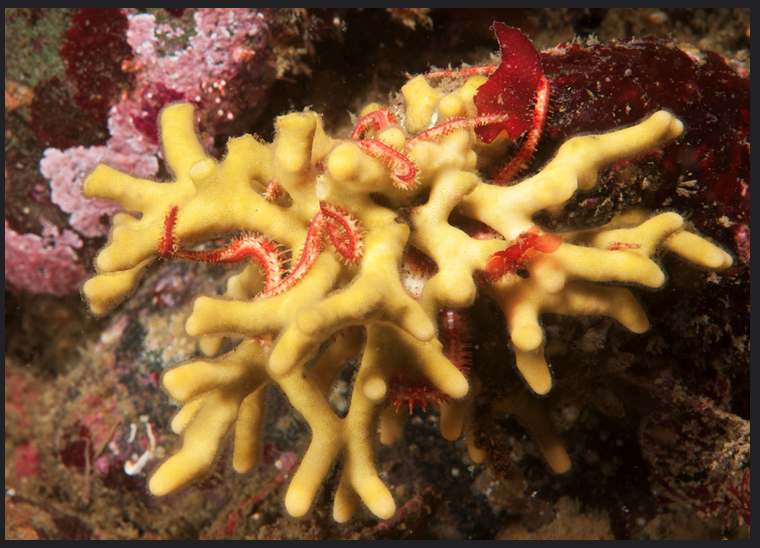
The arms of brittle stars are tangled among the horns of this Heteropora cluster–photo by Ryan Murphy
Heteropora pacifica , the yellow staghorn bryozoa are shown in these pictures .surrounded by the typical associated invertebrates. This bryozoan occurs frequently in small clumps sub-tidally at Race Rocks.
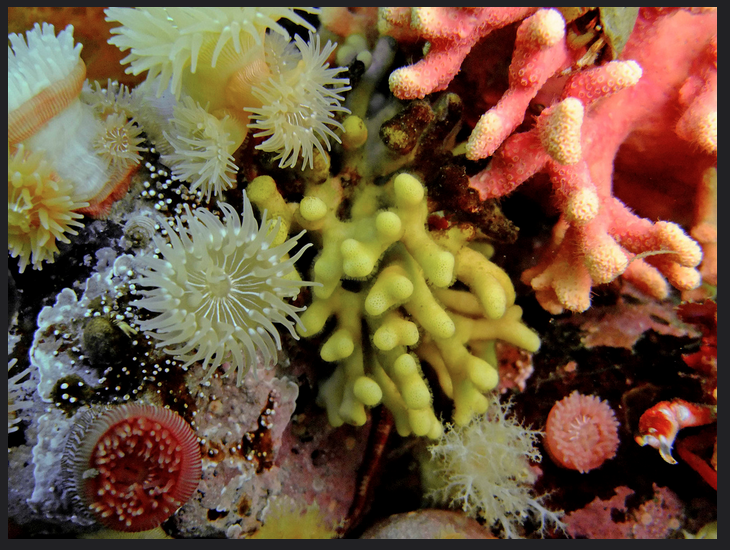
Heteropora pacifica. beside the hydrocoral Allopora sp. and brooding anemone – Photo by Andrew McCurdy.
| Domain | Eukarya |
| Kingdom | Animalia |
| Phylum | Bryozoa |
| Class | Stenolaemata |
| Order | Cyclostomatida |
| Suborder | Ceriopoina |
| Family | Heteroporidae |
| Genus | Heteropora |
| Species | pacifica (Borg, 1933) |
| Common Name: | Staghorn byozoan |
|
This file is provided as part of a collaborative effort by the students, faculty, staff and volunteers of
Lester B. Pearson College |
2006 –Garry Fletcher |
Membranipora serrilamella: Kelp-encrusting Bryozoa
The colonial marine bryozoan Membranipora serrilamella, formerly referred to as Membranipora membranacea. produces a planktonic larva that is encased by a triangular bivalved shell. Following a relatively long free-swimming phase, the larva settles as an epizootic colony on the blade of laminarians and other subtidal marine algae. It then undergoes a metamorphosis to become the sessile progenitor of the colony, referred to as the ancestrula”.
- Still photos of Membranopora serrilamella
- from the video.
Encrusting colonies are typically found on marine algae on the lower shore to shallow water. Found encrustating in kelps and other large seaweeds, especially common on the brown algae Laminaria, but can also be found growing in rocks, glass, floats or other.
Description: This epiphiytic bryozoan forms encrusting lacy matlike colonies of very small, rectangular aurozooids 0.42 x 0.13 mm. with tubercules or short spines in the corners. Each zooid has lateral calcified walls that contain ventral incalcified bands providing flexibility; A frontal membrane completely roofs the space between the supporting side walls with a lophophore (feeding tentacles) visible within. Tower zooids may also be present, where the frontal membrane projects upwards in a columnar way. Forms white, disc-like colonies, approx. 1 mm high and up to and over 100 mm wide. Zooids are rectangular and for together neatly in radially arranged rows that grow outward and branch into new rows as the pattern frows wider.
Additional information: Colonies may vary in size. Membranipora membranecea grows quickly (several mm/ day) in response to predation from sea slugs and in order to maintain its position on the kelp frond. Prolific growth is favoured by fast flowing water which provides food and oxygen. Egg production occurs once a year in the spring; the larva (cyphonautes) is planktotrophic and is the most abundant and largest coastal larva in Britain between June and August. The larva settles in late simmer-early autumn.
Natural history: Colonies are made up of hundreds or thousands of individual zooids, which are not much larger than a pond head. Their eight week growing season falls between late spring and early autumn. During this time, how they grow is dependent upon their success in the competition for space. The interaction between colonies can be cooperative to aggressive depending upon their size. Small colonies communicate by using electrical signals. Large colonies use runners called stolons from which new zooids bud from to mediate aggressive behaviors.
Domain- Eukaryota
Superphylum Prostomia
Phylum Bryozoa
Class Gymnolaemata
Order Cheilostomatida
Suborder: Malacostegina •
Family: Membraniporidae •
Genus: Membranipora de Blainville, 1830
species: M. serriamella
and Image File |
 The Race Rocks taxonomy is a collaborative venture originally started with the Biology and Environmental Systems students of Lester Pearson College UWC. It now also has contributions added by Faculty, Staff, Volunteers and Observers on the remote control webcams. March 8 2005- Fredy ( PC 32) The Race Rocks taxonomy is a collaborative venture originally started with the Biology and Environmental Systems students of Lester Pearson College UWC. It now also has contributions added by Faculty, Staff, Volunteers and Observers on the remote control webcams. March 8 2005- Fredy ( PC 32) |

